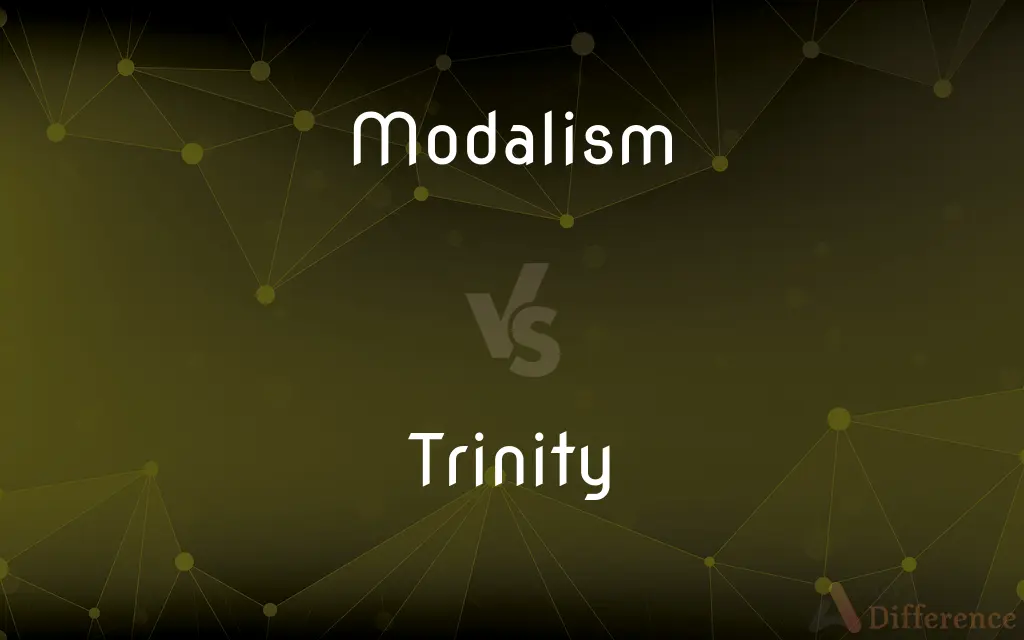Modalism vs. Trinity — What's the Difference?
Edited by Tayyaba Rehman — By Maham Liaqat — Updated on March 19, 2024
Modalism posits that God exists as one person manifesting in three modes or aspects, not simultaneously. The Trinity doctrine describes God as one being in three distinct, coexisting persons: Father, Son, and Holy Spirit.

Difference Between Modalism and Trinity
Table of Contents
ADVERTISEMENT
Key Differences
Modalism, also known as Sabellianism, views God as a singular entity that has revealed Himself in three different forms or modes: as the Father in creation, the Son in redemption, and the Holy Spirit in sanctification. This view emphasizes the unity of God without distinguishing between persons within the Godhead. On the other hand, the Trinity, a central doctrine of mainstream Christianity, teaches that God exists as three distinct persons who are coeternal, coequal, and consubstantial (of the same substance), yet remain one being. Each person of the Trinity is fully God, and there is one God in essence.
While modalism suggests a temporal succession in the manifestations of God, the Trinity posits a perpetual coexistence and relationship between the Father, Son, and Holy Spirit. Modalism faces criticism for oversimplifying the complex nature of God's identity, potentially undermining the distinct roles and relationships within the Godhead as depicted in Christian scripture. Conversely, the Trinity seeks to maintain the biblical portrayal of God's threeness and oneness, holding tension between these aspects without fully resolving the mystery.
In modalism, the distinctions between Father, Son, and Holy Spirit are seen as different modes for different purposes, rather than permanent states of being. Whereas, in Trinitarian belief, the distinctions are inherent and relational, with each person of the Trinity engaging with the others in a dynamic and eternal relationship.
Critics of modalism argue that it fails to account for scriptural instances where the persons of the Godhead interact with each other, such as at Jesus' baptism where the Father speaks from heaven and the Spirit descends as a dove. Trinity advocates view these interactions as evidence of the distinct personal existences within the Godhead.
The debate between modalism and the Trinity reflects broader theological efforts to articulate the nature of God as revealed in Christian scriptures. While both views seek to uphold the doctrine of monotheism, they offer different frameworks for understanding the complexities of God's identity and manifestation.
ADVERTISEMENT
Comparison Chart
Concept of God
One person manifesting in three modes
One being in three distinct, coexisting persons
Persons of Godhead
Modes or aspects, not simultaneously coexistent
Distinct, coeternal, coequal persons
Scriptural Interpretation
Emphasizes the unity and oneness of God
Balances God's unity with the distinctness of persons
Criticisms
Oversimplifies God’s nature; undermines distinctions
Perceived complexity; accused of tritheism by critics
Key Distinction
Temporal succession in God’s manifestations
Perpetual coexistence and relationship among persons
Compare with Definitions
Modalism
Criticized for neglecting the personal distinctions within the Godhead.
Critics argue modalism blurs biblical distinctions between the Father and the Son.
Trinity
One God in three distinct persons.
The Trinity describes God as Father, Son, and Holy Spirit; distinct yet one.
Modalism
Emphasizes God’s indivisible oneness.
Modalism holds that God is undividedly the Father, Son, and Holy Spirit.
Trinity
Each person fully participates in the divine essence.
In Trinitarian belief, the Son is fully God, as are the Father and the Spirit.
Modalism
God as one entity manifesting in three modes.
In modalism, Jesus' baptism is seen as God operating in different modes.
Trinity
Seen in scriptural interactions among the persons.
The Trinity is illustrated at Jesus’ baptism, with the Father speaking and the Spirit descending.
Modalism
Faces opposition for its interpretation of Trinitarian passages.
Modalism reinterprets Trinitarian scriptures to fit its theological framework.
Trinity
Central to mainstream Christian doctrine.
The Trinity is a foundational doctrine in most Christian confessions of faith.
Modalism
Views God's roles as situational manifestations.
Modalism interprets God’s role as the Son as specific to redemption.
Trinity
Maintains both unity and diversity within the Godhead.
The Trinity upholds the coexistence of God’s threeness and oneness.
Modalism
(Christianity) The nontrinitarian doctrine that God, who is one person, has three modes of divine revelation, [the Father, Son, and Spirit], contrary to the orthodox belief that the three persons are all fully God.
Trinity
The Christian doctrine of the Trinity (Latin: Trinitas, lit. 'triad', from Latin: trinus "threefold") holds that God is one God, and exists in the form of three coeternal and consubstantial persons: the Father, the Son (Jesus Christ), and the Holy Spirit. The three persons are distinct, yet are one "substance, essence or nature" (homoousios).
Trinity
A group consisting of three closely related members. Also called triunity.
Trinity
Trinity(Theology) In most Christian faiths, the union of three divine persons, the Father, Son, and Holy Spirit, in one God. Also called Trine.
Trinity
Trinity Trinity Sunday.
Trinity
A group or set of three people or things; three things combined into one.
Trinity
The state of being three; independence of three things; things divided into three.
Trinity
The union of three persons (the Father, the Son, and the Holy Ghost) in one Godhead, so that all the three are one God as to substance, but three persons as to individuality.
Trinity
Any union of three in one; three units treated as one; a triad, as the Hindu trinity, or Trimurti.
Trinity
Any symbol of the Trinity employed in Christian art, especially the triangle.
Trinity
The cardinal number that is the sum of one and one and one
Trinity
The union of the Father and Son and Holy Ghost in one Godhead
Trinity
Three people considered as a unit
Common Curiosities
Why is the Trinity considered a mystery?
The Trinity is considered a mystery because it describes a unique and complex relationship within the Godhead that defies full human understanding, balancing God’s unity and diversity.
Can one be a Christian without believing in the Trinity?
Belief in the Trinity is a central tenet of mainstream Christianity. However, various Christian traditions and individuals may hold different views on the nature of God while still identifying as Christian.
What is the historical origin of modalism?
Modalism, or Sabellianism, originated in the early Christian church as an attempt to explain the monotheistic belief in the context of the scriptural revelations of Father, Son, and Holy Spirit.
How do Trinitarians explain the relationship between the persons of the Trinity?
Trinitarians explain the relationship as one of love, mutual indwelling, and cooperation, with each person fully God yet engaging in distinct roles within the Godhead’s unified work.
How does the Trinity affect the concept of salvation?
In Trinitarian theology, salvation involves all three persons of the Trinity: the Father’s plan, the Son’s sacrifice, and the Spirit’s application of redemption to believers.
Is modalism considered heresy?
Modalism is considered heretical by mainstream Christian denominations that uphold the doctrine of the Trinity, as it contradicts the established understanding of God’s triune nature.
How do modalists view Jesus Christ?
Modalists view Jesus Christ as God manifesting in the mode of the Son for the purpose of human redemption, not as a distinct person separate from the Father or the Spirit.
What are the implications of modalism for Christian worship?
Modalism emphasizes the unity of God, which may affect how God is addressed in prayer and worship, potentially focusing on God's singular essence rather than distinct persons.
How do Trinitarians view the Old Testament?
Trinitarians see hints of the Trinity in the Old Testament, such as the use of plural pronouns for God, interpreted as early revelations of the triune Godhead.
What scripture passages are central to the debate between modalism and the Trinity?
Key passages include those that depict interactions between the Father, Son, and Holy Spirit, such as at Jesus’ baptism (Matthew 3:16-17) and the Great Commission (Matthew 28:19), which are interpreted differently by modalists and Trinitarians.
Share Your Discovery

Previous Comparison
Ngo vs. Foundation
Next Comparison
Septet vs. SestetAuthor Spotlight
Written by
Maham LiaqatEdited by
Tayyaba RehmanTayyaba Rehman is a distinguished writer, currently serving as a primary contributor to askdifference.com. As a researcher in semantics and etymology, Tayyaba's passion for the complexity of languages and their distinctions has found a perfect home on the platform. Tayyaba delves into the intricacies of language, distinguishing between commonly confused words and phrases, thereby providing clarity for readers worldwide.














































